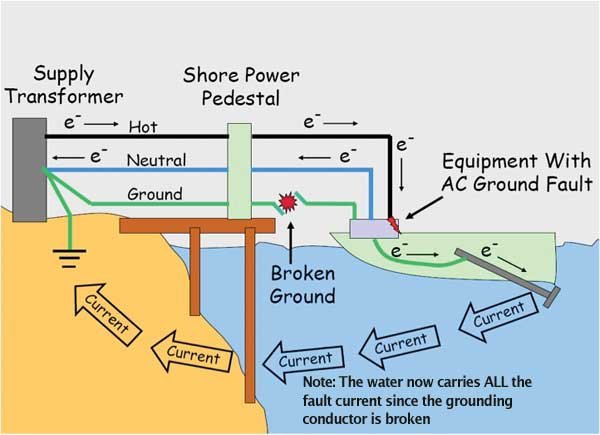As you and your family are trying to stay cool during these hot summer days, we wanted to take a moment to help raise awareness on a topic that is rarely discussed but can quickly take an innocent life without warning…
ELECTRIC SHOCK DROWNING.
WHAT IS ELECTRIC SHOCK DROWNING?
Electric Shock Drowning (ESD) occurs when electricity seeps into the water and essentially, “electrifies it.” As someone enters the water, the electricity paralyzes their muscles, causing them to drown. Although ESD can occur in any location where there is a power source near water, the majority of ESD deaths happen near public and private docks and marinas.
TAKING INNOCENT LIVES…
In 1999, Kevin Ritz’s 8-year old son died when he was swimming in a river near the family boat. No one realized electricity from the boat was seeping into the water. When he grabbed the metal ladder, he received a shock that paralyzed him and caused him to drown. After his son’s death, Ritz founded the ESD Prevention Association and continues to work towards increasing ESD awareness.
Over an innocent July 4th weekend in 2012, Alexandra Anderson, 13, and her brother Brayden Anderson, 8, were swimming near a private dock at the Lake of the Ozarks when they started to scream. Their parents went to their aid, but by the time the siblings were pulled from the lake, they were unresponsive. Both children were pronounced dead after being transported to a nearby hospital. About two hours later, Noah Winstead, a 10-year-old boy, died in a similar manner at Cherokee Lake, near Knoxville, Tennessee, and Noah’s friend, 11-year-old Nate Parker Lynam, was pulled from the water and resuscitated, but died early the following evening. According to local press reports, seven other swimmers were injured near where Noah died. These were not drowning victims. In all of these cases, 120-volt AC (alternating current) leakage from nearby boats or docks electrocuted or incapacitated swimmers in fresh water.
HOW DOES ELECTRICITY ENTER THE WATER?
In a properly functioning electrical system, all of the 120-volt AC current that goes into the boat through the shore power cord returns to its source (the transformer ashore or on the dock where it originated). For any of that current to wind up in the water, three things need to occur:
- Electrical fault. Somewhere current must be escaping from the system and trying to find another path back to its source ashore.
- AC safety ground fault. The AC grounding system must be compromised so that stray current cannot easily return to ground through the ground safety wire. Any stray electricity then has only one path back to its source… through the water.
- No ground fault protection. Any current returning to its source through the water will create a slight (but detectable) difference between the amount of current traveling to the boat and returning from it through the shore power cables. Ground Fault Protection (GFP) devices, like Ground Fault Circuit Interrupters (GFCIs) required in bathrooms ashore, are designed to detect differences measured in milliamps and shut down the electricity within a fraction of a second. If the circuit does not have one, then electricity will continue to flow into the water.
If all of these conditions exist, then some (or all) of the boat’s underwater metals such as the propeller, stern drive or through-hull fittings will be energized, and electricity will radiate out from the fittings into the water.
WHY ELECTRIC SHOCK DROWNING IS A SILENT KILLER:
- There is no visible warning or way to tell if water surrounding a boat, marina or dock is energized (or within seconds will become energized) with fatal levels of electricity.
- In most circumstances, victims do not immediately feel electrical current when they enter and swim in the water. Typically, electricity enters the water when an electrical fault occurs aboard a boat which is often intermittent (i.e., when a light switch is turned on). Water can appear and feel “safe” and in a split second become energized with deadly electricity.
- Under the typical scenario, the victim’s muscles become paralyzed by the electrical current, he or she is unable to swim, and ultimately drowns. Unless there is a witness nearby to experience and report the sensation of electric shock in the water, the victim’s death is typically labeled a common drowning. In the vast majority of ESDs, the victim’s autopsy shows no signs of electrical injury and investigators often never learn that electricity was the cause of the drowning.
It’s difficult to estimate the number of electric shock drownings, because it typically looks the same as other cases of drowning and the victims display no telltale signs. The only way to know is if someone feels the jolt. What’s even more alarming is pools and hot tubs can be just as dangerous. Many times faulty pool lights cause electricity to flood the pool or hot tub, causing fatalities.HOW TO PREVENT ESD?
Perform routine leak checks and ensure a ground fault device is installed on power sources at the breaker. A ground fault device protects the entire power source from its start, and prevents the current from following any unintended paths during a ground fault (contact between an energized conductor and the ground). Kevin Ritz says, “It is so simple and it is so inexpensive.” As an additional safety measure, only use shore- or marine-rated cords and devices in and around boats and docks; inspect cords for damage on a routine basis and always ensure proper storage.
Sources:
https://www.electricshockdrowning.org/esd–faq.html
https://www.boatus.com/seaworthy/magazine/2013/july/electric-shock-drowning-explained.asp
https://www.today.com/health/after-tragedy-parents-raise-awareness-about-electric-shock-drowning-t93761



